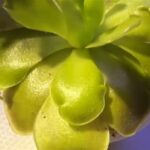As an Amazon Associate, this site earns commissions from qualifying purchases. For more details, click here.
If you want something different for your plant collection, try pinguicula debbertiana. It is known for its purple colors and straightforward cultivation. This Mexican butterwort was discovered in 1989 and is now considered one of the most striking in the pinguicula family. If you want to try your hand caring for these plants, this guide shows you how.
Pinguicula debbertiana requires loose, low nutrient soil and full sunlight. This Mexican butterwort prefers 55-85 degrees and 40-80% humidity. Water regularly to keep the soil moist, but allow the plant to dry during winter after it forms a rosette.
Pinguicula Debbertiana Care Sheet
| Soil | 1:1 perlite and peat moss |
| Water | Purified, distilled, rainwater |
| Light | Full sunlight |
| Food | Bloodworms, fish food, bugs |
| Temperature | 55-85 F (13-30 C) |
| Humidity | 40-80% |
| Dormancy | None, but its carnivorous leaves are replaced by a rosette |
| Propagation | Leaf pulling |
Soil
You can use the standard carnivorous plant soil mix – 1:1 perlite and peat moss – for pinguicula debbertiana. An alternative is equal parts perlite, vermiculite and some silica sand.
You can only use neutral to slightly alkaline substrates. The soil must have no nutrients, drains smoothly and be loose. Most p. debbertiana sold include a soil mix. If given that option, you should buy it. At least you can be certain the potting media is compatible with the plant. Another option is Soil Sunrise which i good for butterworts.
In general your pinguicula should do fine with 1:1 perlite and vermiculite or peat and perlite. Long sphagnum moss should work too though most growers prefer peat. If the soil is for carnivorous plants, it will work.
Whichever mix you prefer, the soil must always be damp. Use a moisture meter if necessary. If your p. debbertiana is not growing fast enough or looks sickly, check the other variables listed here. Do not fertilize the soil because that will kill the plant.
Pot Container
A small pot is all you need for a pinguicula debbertiana. Mature plants reach 1-2 inches in diameter so a 3 inch container is sufficient.
Any plant pot will be fine, even a plastic cup or small box. You can also plant pinguicula on rocks to give it a different aesthetic. You may also grow several p. debbertiana in one large container. As long as each seed Is a few inches away from the next, there should be no problems.
No matter where you plant, location will be important. A sunny window is usually the best place. If light is limited you might consider taking the plant outdoors to get more light. P. debbertiana seems to need more light than the typical Mexican butterwort.
If you ever need to repot, get new soil. It can be the same type but do not use the actual soil in the current container. Turn the pot upside down while holding the plant with one hand. Shake the pot gently and that should loosen all the dirt. Now pour new soil into another pot and plant your ping.
Water
Water plays a major role in plant life and Mexican butterworts are no exception. You have to use the right amount and also choose the correct type. This can make the difference between a healthy and dying pinguicula.
If you have grown Mexican butterworts, the watering process is the same. Water the plant so the soil remains moist throughout its carnivorous phase. During winter, water sparingly and let the rosette dry.
Distilled or purified water is best for p. debbertiana, but you can also use reverse osmosis and rainwater. While tap water is widely available, its mineral content is too high for Mexican butterworts.
Water p. debbertiana from the top. Do not pour into one spot, but rather all over the plant and soil. When the soil is moist, stop watering. Wait for the media to start drying before you water again.
You can use the tray method but with only an inch or so of water. Too much and humidity could damage the roots. If watering from the top works, stick with it.
Light
Pinguicula debbertiana prefers full sunlight. Place the pot on a sunny window or a sunlit spot in your garden. However, do not position the plant directly under the sun. This could lead to sunburn and damage its leaves.
The simplest approach is the old windowsill method. Place the pot on a south facing window. Position it so the plant can get as much light as possible. You should be able to tell if your p. debbertiana gets enough light or not.
Since p debbertiana prefers full light you do not have to worry about sunburn as much as other butterworts. But it can happen especially if it is over 90 degrees. You can use artificial lighting too just like with pinguicula conzattii. The light should be bright and at least 12 inches above the plant.
If you are growing several p. debbertiana in one large container, make sure all the plants are getting enough light. This could be a problem if the plant is indoors and only one part of the container is heavily exposed to the light.
Temperature
Temperature is important for butterworts, not just for growth but also for pollination. Fortunately these Mexican pings can survive in a wide temperature range.
To keep pinguicula debbertiana healthy, the temperature should be 55-85 F (13-30 C). These butterworts should never be exposed to freezing cold. You have to take the plant indoors if it drops below freezing.
Temperature and light are closely linked so you have to manage them together. As pointed out earlier, p. debbertiana prefers full sun. It will survive in partial light but will not grow as fast. However, the temperature usually rises when light intensity increases, so what should you do?
As long as it at 85 degrees or lower, your p. debbertiana is going to be all right. Some of these pings even thrive in 90 degrees. The healthier your butterworts are, the hotter temperature they can withstand. But to be safe, keep the plant at 85 degrees or under.
Humidity
Pinguicula debbertiana needs medium to high humidity, around 40-80%. When combined with the ideal temperature it will help the plant grow faster and become more resistant to disease.
A lot of the focus is usually on the light, water and temperature, but humidity is also crucial. In general, Mexican butterworts prefer medium to high humidity. Some p. debbertiana may survive in less than 50% humidity but it is not going to thrive.
If you have a humidifier you can control this aspect. If you do not have one, your pinguicula can give you clues if the humidity level is sufficient. If its leaves are sticky, then the plant is doing fine. If the leaves are dry, you need to increase humidity around it.
Nutrition and Feeding
Pinguicula debbertiana trap and eat bugs the same way other butterworts do, by luring them into their sticky leaves. If your ping catches flies and other insects regularly, it is getting enough nutrients. Combine this with glucose from photosynthesis and your plant is fine.
You may feed p. debbertiana or any butterwort if they are unable to trap any prey (for example, if the plant is in a terrarium). There are a lot of food choices but we like Jessi Mae Freeze Dried Mealworms because it is healthy.
You may give butterworts some fertilizer food. You cannot use this on the soil, but you can dilute fertilizer in water and sprinkle a bit onto its leaves. The typical mix is one fourth fertilizer per gallon of water. Do this only if you have experience as this could be risky for the plant.
Dormancy
Pinguicula debbertiana does not go through dormancy. However the plant enters a succulent phase in winter. During the cold season, these butterworts discard their carnivorous leaves and turn into succulent rosettes.
Pinguicula debbertiana do not have any means of surviving deep, long winter frosts. Move the plant indoors and keep it at 55-85 F. Its rosettes do not require a lot of water so it is all right to let it dry. You may lightly water if the humidity gets too low.
When winter ends, the plant will sprout new carnivorous leaves. You can repot the plant or propagate just before these leaves sprout.

My fascination with carnivorous plants began many, many years ago with Venus Fly Traps. Now I am more than happy to impart what I know with other enthusiasts and those who are curious about meat eating plants.



